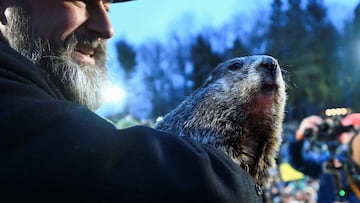What is the history and origin of Groundhog Day?
Across North America groundhogs are disturbed from the winter slumber on 2 February to divine when spring will come. But where does the tradition come from?

Winters in the higher latitudes of the Northern Hemisphere can be harsh so the coming of Spring and warmer weather is looked forward to. While meteorology has improved greatly over the years at forecasting what Mother Nature has in store, some still like to rely on four-legged, furry oracles.
The most famous of these prognosticators of the arrival of springtime or eternal winter is Punxsutawney Phil. Every year for well over a century people have made there way to Gobbler’s Knob in the western Pennsylvanian town which is the namesake of the immortal rodent forecaster. Since the 1993 movie ‘Groundhog Day’ made the critter a household name, attendance has skyrocketed with tens of thousands flocking to Punxsutawney for his prediction.
Phil is not alone though, with groundhogs, and other hibernating creatures, across North America awaken from their winter slumber on 2 February to divine when spring will come. But where does the tradition come from?
European roots of Groundhog Day
Groundhogs are one of several animals that hibernate during the winter, awaking from their slumber when spring arrives. Thus it makes sense to look to them and their other hibernating peers in the animal kingdom to divine when warmer weather will be expected to stay. In Germanic parts of Europe, bears were originally used but upon becoming harder to find due to dwindling numbers, badgers made for a good substitute.
The year's best holiday is only two days away! Here are some Groundhog Day facts to get you excited! pic.twitter.com/3drv4Fabxe
— Madi Baggett (@madithemet) January 31, 2023
The Christian festival of Candlemas was the official end to the Christmas period in medieval Europe. It falls on 2 February, and people would use the weather and how the animals reacted on that day to foretell when winter would come to an end. If the weather was sunny and a badger decided to soak up the warm light, that would forebode a prolonged winter.
The origins of Groundhog Day in America
German-speaking immigrants to America brought the tradition with them, however the plentiful groundhogs became the animal of choice. Groundhogs, unlike badgers, will return to their burrows on sunny days. The superstition goes that when a groundhog emerges from its burrow and sees its shadow, it will scurry back in and winter will last another six weeks.
Almost Groundhog Day pic.twitter.com/GbArGPDsse
— Garrett Smithley (@GarrettSmithley) January 29, 2023
A report in the Punxsutawney Spirit newspaper from 1886 is credited as the earliest recorded mention of a Groundhog Day celebration. It read: “up to the time of going to press, the beast has not seen its shadow.” But it wasn’t until the following year that the first official Groundhog Day celebration took place. Every year now thousands of people gather at a site called Gobbler’s Knob, where a group of local dignitaries known as the “Inner Circle” decipher Phil’s prediction. A record of all the predictions minus 10 have been kept.
How accurate are Punxsutawney Phil’s predictions?
The statistical probability of getting a coin toss right is 50 percent. But over his 137 years so far in the weather forecasting business, Punxsutawney Phil has been subpar in his predictions.
Related stories
But then again, he’s held to a high standard as the most well-known groundhog, tasked with predicting the weather for the entire nation when he only sees his shadow, or not, in Punxsutawney, Pennsylvania.
Follow all the latest news on AS USA.


